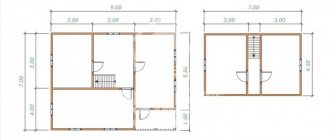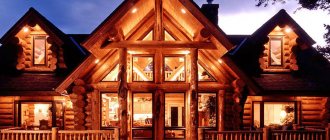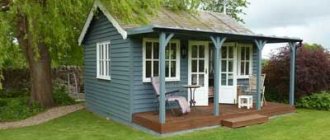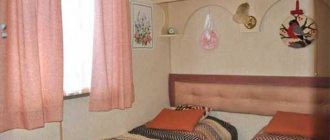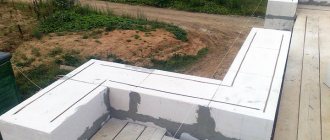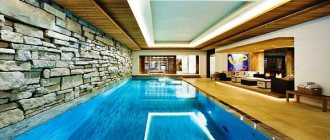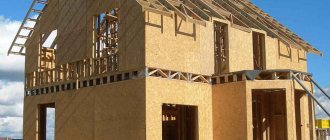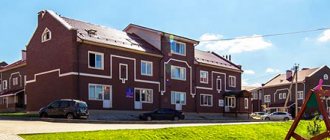Dreaming of their own home, people want to build it as quickly as possible and work hard on construction sites from spring to late autumn in order to have time to complete a large amount of work before the cold weather. Building a house in winter seems unthinkable to many, so with the onset of frost in November and early December, the process is postponed until April, which prolongs the construction time of the home.
Meanwhile, there are people who continue or are just starting to work during the cold season. They complete the process of building a house before those who like to put it off until spring. In this regard, it is necessary to consider whether it is possible to build a house in winter or whether this should not be done.
Pros and cons of building a house in winter
Advantages of winter construction
At first glance, it may seem that it is difficult to find the advantages of building a house in winter. But in fact there are quite a lot of them:
- Cost of materials and work. The winter period is considered a low season, so suppliers offer good discounts on building materials. In winter you can get a discount of up to 15%, and maybe more if you bargain well. In addition to the reduced prices for materials, you will also be pleased with the favorable cost of the work itself - construction crews are happy to take on the work, because there is not enough of it. Another advantage will be the fact that the builders will not rush to complete as many orders as possible, and can do the work better.
- Convenient access to the construction site. Construction of houses in winter can be considered convenient because... the ground freezes and is leveled thanks to the snow, which makes it much easier to transport construction materials and drive heavy equipment. In the spring, the roads wash out and turn into pure mud.
- The soil and landscape are preserved. For the reasons described above, the soil is well preserved because the ground freezes and is not exposed to much impact from heavy construction equipment. In the warm season, the top layer of soil may be damaged and it will take time to restore it.
- Construction time is reduced. By starting construction in winter, you will shorten the construction period - by spring the box will be ready and you can begin finishing.
- It is easier to work with loose soil because... he will be frozen.
- Winter is suitable for wood construction. Due to the low humidity, winter time is excellent for construction with timber/logs. Wood in winter contains less moisture, which is why it will crack less when drying. It is also more convenient to store it in cold weather - the tree will not rot and insects will not infest it. Therefore, if you doubted whether it was possible to build a wooden house in winter, it is possible, and even necessary.
- Convenient to store materials. Firstly, it’s simply cleaner in winter. Secondly, materials can be stored simply by covering them, protecting them from snow; there is no need to make pallets (which are needed so that the material does not absorb moisture from the ground).
- There are fewer neighbors in winter
because Usually everything is built in the warm season. You will not disturb anyone with the noise of construction work and dirt.
Disadvantages of winter construction
- Short daylight hours and bad weather conditions complicate the construction process.
- Additional work with concrete. In winter, concrete needs heating and special plasticizer additives, otherwise the quality of concrete may suffer due to frozen water inside the pores.
- Additional expenses. You will have to spend additional electricity for lighting, heating the cabin, heating the concrete and purchasing additives.
- It is more difficult to dig the soil because he's frozen.
- It is more difficult to carry out finishing work. Interior finishing work associated with wet processes cannot be carried out at sub-zero temperatures, and it is difficult to provide heat to a newly built house.
Interior decoration
The finishing of the room is carried out with an indoor temperature of +15 degrees and mandatory ventilation. At these degrees you can plaster, paint, lay linoleum, parquet or laminate. But if there is no proper ventilation, there will be condensation on the wallpaper, windows, and flooring. Which in turn will definitely ruin your materials. The cement screed dries for at least two weeks, subject to daily ventilation. The surface crust can be misleading - after all, the bulk will be raw. If ventilation is poor, it is undesirable to work with oil and other paints; they emit harmful substances for humans, and the smell of the paint will remind you of insufficient ventilation for a long time.
If the room is not heated, you can install points for radiators, arrange a subfloor, and carry out wiring. Cleaning work should be carried out only in warm mode.
Features of winter construction
What you will need to carry out construction work in winter:
- Provide workers with a warm cabin with heating and light sources;
- Take care of heating the concrete; you will need special equipment and possibly the help of specialists. You will also need special additives for the mortar.
- When performing piling work, you will have to work hard; soil development will be necessary (mechanical or heating);
- Special additives to the brickwork mortar will be required, as well as its heating.
- It is necessary to follow special construction technology depending on the material.
Concrete work in winter
The most difficult thing in concrete work in winter is to prevent the mortar from freezing until it has gained the necessary strength. This will require the use of chemical additives that reduce the freezing point of water and accelerate the hardening of concrete, as well as heating the concrete (electric heating, heating with electrodes, infrared heating, the “thermos” method, etc.) It is recommended to maintain a positive temperature of all components of concrete.
Pile foundation
An alternative to a concrete foundation can be a foundation on screw piles
. Supports of this kind are made of steel pipes. Each has a cutting blade and a head on which the grillage is fixed.
A pile-screw foundation has many advantages. It does not require extensive excavation work or the use of heavy equipment. Thanks to this, such a foundation for a house is 30–40% cheaper than a traditional strip or slab foundation. "Wet" processes are excluded. There is no need to wait until the foundation gains strength to ensure load-bearing capacity. The piles are ready to accept load immediately after screwing in, which significantly reduces construction time. And finally, the main advantage is that work can be carried out year-round.
Screw piles can be screwed even into frozen soil. After the pipe is immersed in the ground to the calculated depth, it is filled with concrete of a grade not lower than M300. And in order to combine all the supports into a solid structure, they are fastened with a channel, timber or reinforced concrete grillage.
The ease of installation of piles may be alarming, but as practice shows, they form a strong and reliable foundation with high load-bearing capacity. Thus, a screw support 2.5 m long, 108 mm in diameter, with a barrel wall thickness of 4 mm and a blade diameter of 300 mm can withstand a load of at least 5 tons.
Is it possible to build a house from timber in winter?
Are houses made of timber built in winter? Of course, because building with wood in the cold season has many advantages.
Firstly, at low temperatures the wood contains less moisture, which means the likelihood of rotting is reduced. Secondly, timber dried in frost will be more durable, which will reduce the likelihood of cracks forming. It can also be noted that in winter the wood is easier to process and retains its geometric shape. Be sure to protect the material from moisture - this will preserve its properties during construction in winter.
A wooden house built in winter quickly shrinks (about two months), so in the spring you can safely begin finishing.
Is it possible to build a house from aerated concrete in winter?
Aerated concrete is not the best material option for winter construction. Points to take into account:
- It is necessary to heat the gas blocks, otherwise the water and glue will freeze;
- The gas blocks will have to be watered with almost boiling water, otherwise the water will immediately freeze;
- Do not place gas blocks on ice;
- Do not heat the mixture with boiling water - the cement will lose its properties;
- You will have to keep the glue in a container with thick walls and a lid, otherwise it will quickly freeze. It also needs to be diluted with hot water, but not boiling water;
- Waterproofing of the material is necessary, since moisture inside the aerated block when freezing can damage its integrity.;
- Finishing of aerated block facades is definitely necessary, because... cellular material is afraid of dampness.
Is it possible to build a brick house in winter?
Building brick houses in winter is quite common. The same difficulties arise here as with any winter construction. Therefore, whether to build brick houses in winter is up to you. Things to consider:
- It is necessary to use modifiers to reduce the freezing threshold;
- It is necessary to constantly thoroughly clean the brick from snow and ice;
- As mentioned above, do not heat mixtures with boiling water;
- It is not recommended to carry out facing masonry in winter;
- Use solutions with a grade one or two higher than the design one (depending on the air temperature).
- It is better not to use cement of a grade lower than M500
Laying walls.
Masonry can be done in any weather conditions, regardless of the time of year. But it is necessary to take into account some features. Let's look at them.
Features of masonry in summer and winter. Clickable.
The marking of the concrete used is of great importance on the quality of the concrete mixture. It is recommended to use concrete marking M500 and higher.
What is the best house to build in winter?
Let's highlight building materials that are used in any season:
- Thermoblocks are concrete in permanent formwork made of polystyrene foam boards. The advantage of the material is that the formwork walls protect the concrete from rapid heat loss, which is necessary for its uniform hardening.
- Any metal structures that are connected by welding.
- SIP panels and wood can also be used in winter. They undergo special processing and are stored in special conditions, so they do not need thorough drying.
Difficulties in carrying out excavation work
It happens that circumstances force excavation work to be carried out in winter. If you find yourself in exactly this situation, then consider the following points:
- The soil should be prepared while it is warm outside. This preparation means draining the soil, because it is wet soil that freezes. The desired result can be achieved by installing drainage ditches around the perimeter of the building site. There are other ways.
- The simplest and most effective method is to saturate the soil with salt solutions. By combining with water in the soil, salt increases its heat capacity. Thermal conductivity also decreases, which leads to a decrease in the freezing point. It is necessary to sprinkle the land with salt during the autumn rains so that the water that goes into the ground saturates the ground to the required depth.
Salt prevents water from freezing
. Tip! If the building site is very large, it will take a lot of salt to salt it out. It is much easier to use the following method, especially considering that the material suitable for this can then be used to insulate a house.
- We are talking about insulating the soil, which will prevent it from freezing during frosts. It is produced using extruded polystyrene foam and dense mineral wool. The latter material is afraid of water, losing its thermal insulation properties, so it must be additionally covered with a waterproofing film.
From the author! The disadvantage of this approach is that by the time the construction time comes, all the insulation can be stolen by unscrupulous enterprising citizens. To prevent this from happening, simply hide the material from view by sprinkling some soil on top of it.
- Another popular method is plowing and harrowing. In warm weather, the soil is plowed to its maximum depth, then the top layer is harrowed. This effect saturates it with air, which is an effective insulation. In fact, a fur coat is created that covers the thickness of the earth from freezing. Very effective, and most importantly, cheap.
Soil development in winter is difficult
- The last method will be good for those who are not prepared at all. The soil is artificially heated and then removed layer by layer. For this purpose, special power stations are used. This method is the most expensive and is used very rarely for private construction.


